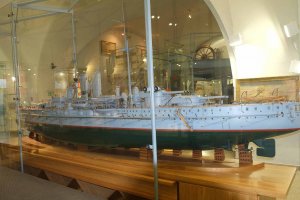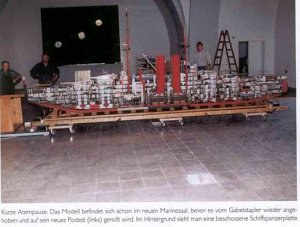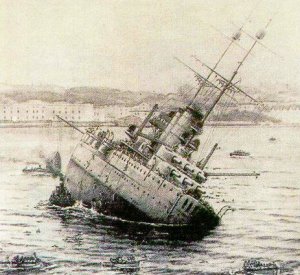SMS Szent István was a Tegetthoff-class dreadnought of the Austro-Hungarian Navy, the only one built in the Hungarian part of Austria-Hungary. The Ganz & Company's Danubius Yard in Hungarian-owned Fiume (current-day Rijeka) was awarded the contract to build the battleship in return for the Hungarian government agreeing to the 1910 and 1911 naval budgets. She was named after Hungary's first Christian king, Saint Stephen (Hungarian: Szent István). She and her sister ships were regarded as very compact and powerful ships and were the first dreadnoughts in service with triple main-gun turrets.
Her completion was delayed by the start of World War I, but she was commissioned in December 1915. She spent the bulk of the war safely anchored in Pola (Pula), leaving harbour generally only for gunnery training. Her final mission began on the evening of 9 June 1918 when she sailed to rendezvous with the other dreadnoughts for an attack on the Otranto Barrage, scheduled for the following day. Two Italian MAS, a type of motor torpedo boat employed by the Regia Marina, discovered Szent István and her half-sister Tegetthoff early in the morning of 10 June 1918 while returning after a night patrol off the Dalmatian coast. They penetrated past her escorts and torpedoed her twice abreast her boiler rooms. They flooded, which knocked out power to the pumps, and Szent István capsized less than three hours after being torpedoed. All but 89 of her crew were rescued. She is the only battleship whose sinking was filmed during World War I.
Her wreck was discovered in the mid-1970s, upside down, off the Croatian island of Premuda. She has been declared a protected site by the Croatian Ministry of Culture and casual diving is forbidden.
Design
Szent István differed from her half-sisters mainly in her machinery. She only had two shafts and two turbines, unlike the four shaft arrangement of the other ships of her class. External differences included a platform built around the fore funnel which extended from the bridge to the after funnel and on which several searchlights were installed. A further distinguishing feature was the modified ventilator trunk in front of the mainmast. She was the only ship of her class not to be fitted with torpedo nets.
General characteristics
Szent István had an overall length of 152.18 metres (499 ft 3 in), a beam of 28 metres (91 ft 10 in), and a draught of 8.6 metres (28 ft 3 in) at deep load. She displaced 20,008 tonnes (19,692 long tons) at load and 21,689 tonnes (21,346 long tons) at deep load. The skegfor each propeller shaft was a solid, blade-like fitting, unlike the strut-type skegs used in her half-sisters, that had such a high transversal resistance that the rudder could only be laid at a maximum angle of 10° at full speed to avoid a heavy list. The hull was built with a double bottom 1.22 metres (4 ft 0 in) deep with a reinforced inner bottom that consisted of two layers of 25-millimetre (1 in) plates.
She was fitted with two AEG-Curtis steam turbines, each of which was housed in a separate engine-room. The turbines were powered by twelveBabcock & Wilcox boilers in two boiler rooms. The turbines were designed to produce a total of 26,000 shaft horsepower (19,388 kW), enough for her designed speed of 20 knots (23 mph; 37 km/h), but no figures from her trials are known to exist. She carried 1,844.5 tonnes (1,815.4 long tons) of coal, and an additional 267.2 tonnes (263.0 long tons) of fuel oil that was to be sprayed on the coal to increase its burn rate. At full capacity, she could steam for 4,200 nautical miles (7,800 km) at a speed of 10 knots (12 mph; 19 km/h).
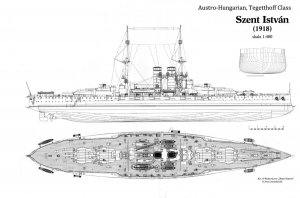
Szent István mounted twelve 305-millimetre (12 in)/45-caliber K 10 guns in four triple turrets. Her secondary armament consisted of twelve 15-centimetre (5.91 in)/50 K 10 guns mounted in casemates amidships. Twelve 66-millimetre (3 in)/50 K 10 guns were mounted on open pivot mounts on the upper deck, above the casemates. Three more 66-mm K 10 guns were mounted on the upper turrets for anti-aircraft duties. Four 21-inch (530 mm) submerged torpedo tubes were fitted, one each in the bow, stern and on each broadside; twelve torpedoes were carried.
The waterline armour belt of the Tegetthoff-class dreadnoughts measured 280 millimetres (11 in) thick between the midpoints of the fore and aft barbettes and thinned to 150 millimetres further towards the bow and stern, but did not reach either the bow or the stern. It was continued to the bow by a small patch of 110–130-millimetre (4–5 in) armour. The upper armour belt had a maximum thickness of 180 millimetres (7 in), but it thinned to 110 millimeters from the forward barbette all the way to the bow. The casemate armour was also 180 millimetres thick. The sides of the main gun turrets, barbettes and main conning tower were protected by 280 millimetres (11 in) of armour, except for the turret and conning tower roofs which were 60 to 150 millimetres (2 to 6 in) thick. The thickness of the decks ranged from 30 to 48 millimetres (1 to 2 in) in two layers. The underwater protection system consisted of the extension of the double bottom up to the lower edge of the waterline armour belt, with a thin 10-millimetre (0.4 in) plate acting as the outermost bulkhead. It was backed by a torpedo bulkhead that consisted of two layered 25-millimetre plates. The total thickness of this system was only 1.6 metres (5 ft 3 in) which made it incapable of containing a torpedo warhead detonation ormine explosion without rupturing.
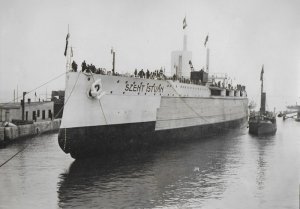
The construction and launhcing of the SMS Szent István
Construction
The ship was laid down on 29 January 1912 at Ganz & Company's Danubius yard at Fiume (current-day Rijeka), the only large Hungarian shipyard in Croatia as Hungarian: János Hunyadi, commemorating the Hungarian national hero. Ganz & Company was awarded the contract to build the battleship in return for the Hungarian government agreeing to the 1910 and 1911 naval budgets. This involved great expense by the Hungarian government, as the yard had hitherto only built smaller merchant ships for, amongst others, Österreichischer Lloyd, and therefore had to be itself refitted for the building of larger vessels. However she was renamed Szent István by order of the Emperor Franz Joseph before she was launched on 17 January 1914. It was customary for either the Emperor or his heir to be present at the launching of a major warship, but Franz Joseph was too feeble and his heir, Archduke Franz Ferdinand, refused to be there as a consequence of his anti-Hungarian attitudes. Franz Joseph sent a telegram of congratulations that negated the snub offered by his heir. During the launching itself there was an accident when the starboard anchor had to be dropped to prevent the ship from hitting a ship carrying spectators, but the anchor chain had not been shackled to the ship and it struck two dockworkers, killing one and crushing the arm of the other. Her fitting out was delayed by the start of the war, but she was finally commissioned on 13 December 1915.
Tegetthoff-class battleships in Pola in 1915. The ship in the foreground is SMS Szent István – Image: Tegetthoff class battleships in Pola 1915
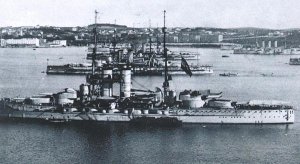
Service
Szent István was based at Pola (Pula) for the duration of her career. In fact she rarely left port except for gunnery practice in the nearby FažanaStrait. She only spent 54 days at sea during her 937 days in service and made only a single, two-day, trip to Pag Island. Only 5.7% of her life was spent at sea; for the rest of the time she swung at anchor in Pola Harbour. She was never even drydocked to get her bottom cleaned.
Film about the artillery exercises of SMS Szent István in 1915
Her tenure in Pola was enlivened by a visit from the new Emperor Karl I on 15 December 1916 and another by Kaiser Wilhelm on 12 December 1917 during his inspection of the German submarine base there. The Italians conducted no fewer than eighty air raids on Pola between 1915 and 1917 which undoubtedly kept the crews of her anti-aircraft gun busy.
Sinking
By 1918, the Allies had strengthened their blockade on the Strait of Otranto. As a result, it was becoming more difficult for German and Austro-Hungarian U-boats to get through the strait and into the Mediterranean. In response to these new measures at blockading the straits, the new commander of the Austro-Hungarian Navy, Konteradmiral Miklós Horthydecided to launch an attack on the Allied defenders with battleships, scout cruisers, and destroyers. During the night of 8 June, Horthy left the naval base of Pola with Viribus Unitis and Prinz Eugen. At about 11:00 pm on 9 June 1918 Szent István and Tegetthoff,escorted by one destroyer and six torpedo boats, departed Pola, after some troubles getting the harbour defense barrage opened. They were en route to the harbour at Slano, north ofDubrovnik (Ragusa) to rendezvous with Viribus Unitis and Prinz Eugen, for a coordinated attack on the Otranto Barrage. At about 3:15 am on 10 June, two Italian MAS boats, MAS 15 and MAS 21, spotted the smoke from the Austrian ships while returning from an uneventful patrol off the Dalmatian coast. The MAS platoon was commanded by Capitano di corvetta Luigi Rizzo, who had sunk the Austro-Hungarian coastal defense ship SMS Wien in Trieste six months before. The individual boats were commanded by Capo timoniereArmando Gori and Guardiamarina di complemento Giuseppe Aonzo respectively. Both boats successfully penetrated the escort screen and split to engage each of the dreadnoughts.MAS 21 attacked Tegetthoff, but her torpedoes failed to hit the ship. MAS 15 fired her two torpedoes successfully at 3:25 am at Szent István. Both boats evaded any pursuit although MAS 15 had to discourage the torpedo boat Tb 76 by dropping depth charges in her wake. Tegetthoff thought that the torpedoes were fired by submarines and pulled out of the formation and started to zigzag to throw off any further attacks. She repeatedly fired on suspected submarine periscopes until she rejoined her half-sister at 4:45.
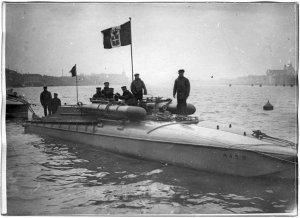
Szent István was hit by two 45-centimetre (18 in) torpedoes abreast her boiler rooms. The aft boiler room quickly flooded and gave the ship a 10° list to starboard. Counterflooding of the portside trim cells and magazines reduced the list to 7°, but efforts to use collision mats to plug the holes failed. While this was going on the dreadnought steered for the nearbyBay of Brgulje at low speed. However, water continued to leak into the forward boiler room and eventually doused all but the two boilers on the port side. This killed the power for the pumps and only left enough electricity to run the lights. The turrets were trained to port in a pointless effort to counter the list and their ready ammunition was thrown overboard.An attempt by Tegetthoff to take the crippled battleship into tow was also abandoned after it became clear that Szent István was doomed.Flooding continued, and the ship capsizedat 6:05 am off Premuda Island. Only 89 sailors died—41 from Hungary—the low death toll partly attributed to the fact that all sailors with the KuK Navy had to learn to swim before entering active service.
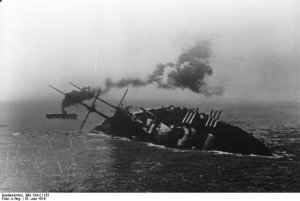
Film footage exists of Szent István 's last half-hour, taken by Linienschiffsleutnant Meusburger of the Tegetthoff with his own camera as well as by an official film crew. The two films were later spliced together and exhibited in the United States during the Great Depression.
The wreck of the Szent István was located in the mid-1970s by the SFR Yugoslav Navy. She is upside down at a depth of 66 metres (217 ft).Her bow broke off when it hit the seabed while the stern was still afloat, but is immediately adjacent to the rest of the heavily encrusted hull. The two holes from the torpedo hits are visible in the side of the ship as is another deep hole which may be from a torpedo fired at Tegetthoff by MAS 21. She is a protected site of the Croatian Ministry of Culture and diving is forbidden without permission. In 2008, divers from Hungary placed a wreath on the Szent István 's wreck during a ceremony that was attended by members of the Austrian and Croatian governments. All three countries were once part of the Austro-Hungarian Empire.
Consequences
Konteradmiral Miklós Horthy, commander of the proposed attack, cancelled the attack because he thought that the Italians had discovered his plan and ordered the ships to return to Pola.
In fact the Italians did not even discover that the Austrian dreadnoughts had departed Pola until later on 10 June when aerial reconnaissance photos revealed that they were no longer there.Capitano di fregata Luigi Rizzo was awarded his second Gold Medal of Military Valor, his first was for sinking the pre-dreadnought battleship Wien in 1917, and appointed a knight in the Order of the Crown of Italy. After the war MAS 15was installed in the Monument to Vittorio Emanuele II as part of the Museo del Risorgimento in Rome. The anniversary of the sinking has been celebrated by the Regia Marina, and its successor, the Marina Militare, as its Navy Day (Italian: Festa della Marina).
A film documentation in german language (45 min)
A beautifull building log (2 parts) of a 1:100 scale model completely in metal built by a hungarian modeler
http://www.shipmodell.com/index_files/0SZENTISTVAN1.html
Further information about the wreck:
https://web.archive.org/web/2011071...eng/index.php?f=wrecks&up=1&url=scent_istvan&
http://croatian-treasure.com/szent.html
info from Wikipedia and others
Her completion was delayed by the start of World War I, but she was commissioned in December 1915. She spent the bulk of the war safely anchored in Pola (Pula), leaving harbour generally only for gunnery training. Her final mission began on the evening of 9 June 1918 when she sailed to rendezvous with the other dreadnoughts for an attack on the Otranto Barrage, scheduled for the following day. Two Italian MAS, a type of motor torpedo boat employed by the Regia Marina, discovered Szent István and her half-sister Tegetthoff early in the morning of 10 June 1918 while returning after a night patrol off the Dalmatian coast. They penetrated past her escorts and torpedoed her twice abreast her boiler rooms. They flooded, which knocked out power to the pumps, and Szent István capsized less than three hours after being torpedoed. All but 89 of her crew were rescued. She is the only battleship whose sinking was filmed during World War I.
Her wreck was discovered in the mid-1970s, upside down, off the Croatian island of Premuda. She has been declared a protected site by the Croatian Ministry of Culture and casual diving is forbidden.
Design
Szent István differed from her half-sisters mainly in her machinery. She only had two shafts and two turbines, unlike the four shaft arrangement of the other ships of her class. External differences included a platform built around the fore funnel which extended from the bridge to the after funnel and on which several searchlights were installed. A further distinguishing feature was the modified ventilator trunk in front of the mainmast. She was the only ship of her class not to be fitted with torpedo nets.
General characteristics
Szent István had an overall length of 152.18 metres (499 ft 3 in), a beam of 28 metres (91 ft 10 in), and a draught of 8.6 metres (28 ft 3 in) at deep load. She displaced 20,008 tonnes (19,692 long tons) at load and 21,689 tonnes (21,346 long tons) at deep load. The skegfor each propeller shaft was a solid, blade-like fitting, unlike the strut-type skegs used in her half-sisters, that had such a high transversal resistance that the rudder could only be laid at a maximum angle of 10° at full speed to avoid a heavy list. The hull was built with a double bottom 1.22 metres (4 ft 0 in) deep with a reinforced inner bottom that consisted of two layers of 25-millimetre (1 in) plates.
She was fitted with two AEG-Curtis steam turbines, each of which was housed in a separate engine-room. The turbines were powered by twelveBabcock & Wilcox boilers in two boiler rooms. The turbines were designed to produce a total of 26,000 shaft horsepower (19,388 kW), enough for her designed speed of 20 knots (23 mph; 37 km/h), but no figures from her trials are known to exist. She carried 1,844.5 tonnes (1,815.4 long tons) of coal, and an additional 267.2 tonnes (263.0 long tons) of fuel oil that was to be sprayed on the coal to increase its burn rate. At full capacity, she could steam for 4,200 nautical miles (7,800 km) at a speed of 10 knots (12 mph; 19 km/h).

Szent István mounted twelve 305-millimetre (12 in)/45-caliber K 10 guns in four triple turrets. Her secondary armament consisted of twelve 15-centimetre (5.91 in)/50 K 10 guns mounted in casemates amidships. Twelve 66-millimetre (3 in)/50 K 10 guns were mounted on open pivot mounts on the upper deck, above the casemates. Three more 66-mm K 10 guns were mounted on the upper turrets for anti-aircraft duties. Four 21-inch (530 mm) submerged torpedo tubes were fitted, one each in the bow, stern and on each broadside; twelve torpedoes were carried.
The waterline armour belt of the Tegetthoff-class dreadnoughts measured 280 millimetres (11 in) thick between the midpoints of the fore and aft barbettes and thinned to 150 millimetres further towards the bow and stern, but did not reach either the bow or the stern. It was continued to the bow by a small patch of 110–130-millimetre (4–5 in) armour. The upper armour belt had a maximum thickness of 180 millimetres (7 in), but it thinned to 110 millimeters from the forward barbette all the way to the bow. The casemate armour was also 180 millimetres thick. The sides of the main gun turrets, barbettes and main conning tower were protected by 280 millimetres (11 in) of armour, except for the turret and conning tower roofs which were 60 to 150 millimetres (2 to 6 in) thick. The thickness of the decks ranged from 30 to 48 millimetres (1 to 2 in) in two layers. The underwater protection system consisted of the extension of the double bottom up to the lower edge of the waterline armour belt, with a thin 10-millimetre (0.4 in) plate acting as the outermost bulkhead. It was backed by a torpedo bulkhead that consisted of two layered 25-millimetre plates. The total thickness of this system was only 1.6 metres (5 ft 3 in) which made it incapable of containing a torpedo warhead detonation ormine explosion without rupturing.

The construction and launhcing of the SMS Szent István
Construction
The ship was laid down on 29 January 1912 at Ganz & Company's Danubius yard at Fiume (current-day Rijeka), the only large Hungarian shipyard in Croatia as Hungarian: János Hunyadi, commemorating the Hungarian national hero. Ganz & Company was awarded the contract to build the battleship in return for the Hungarian government agreeing to the 1910 and 1911 naval budgets. This involved great expense by the Hungarian government, as the yard had hitherto only built smaller merchant ships for, amongst others, Österreichischer Lloyd, and therefore had to be itself refitted for the building of larger vessels. However she was renamed Szent István by order of the Emperor Franz Joseph before she was launched on 17 January 1914. It was customary for either the Emperor or his heir to be present at the launching of a major warship, but Franz Joseph was too feeble and his heir, Archduke Franz Ferdinand, refused to be there as a consequence of his anti-Hungarian attitudes. Franz Joseph sent a telegram of congratulations that negated the snub offered by his heir. During the launching itself there was an accident when the starboard anchor had to be dropped to prevent the ship from hitting a ship carrying spectators, but the anchor chain had not been shackled to the ship and it struck two dockworkers, killing one and crushing the arm of the other. Her fitting out was delayed by the start of the war, but she was finally commissioned on 13 December 1915.
Tegetthoff-class battleships in Pola in 1915. The ship in the foreground is SMS Szent István – Image: Tegetthoff class battleships in Pola 1915

Service
Szent István was based at Pola (Pula) for the duration of her career. In fact she rarely left port except for gunnery practice in the nearby FažanaStrait. She only spent 54 days at sea during her 937 days in service and made only a single, two-day, trip to Pag Island. Only 5.7% of her life was spent at sea; for the rest of the time she swung at anchor in Pola Harbour. She was never even drydocked to get her bottom cleaned.
Film about the artillery exercises of SMS Szent István in 1915
Her tenure in Pola was enlivened by a visit from the new Emperor Karl I on 15 December 1916 and another by Kaiser Wilhelm on 12 December 1917 during his inspection of the German submarine base there. The Italians conducted no fewer than eighty air raids on Pola between 1915 and 1917 which undoubtedly kept the crews of her anti-aircraft gun busy.
Sinking
By 1918, the Allies had strengthened their blockade on the Strait of Otranto. As a result, it was becoming more difficult for German and Austro-Hungarian U-boats to get through the strait and into the Mediterranean. In response to these new measures at blockading the straits, the new commander of the Austro-Hungarian Navy, Konteradmiral Miklós Horthydecided to launch an attack on the Allied defenders with battleships, scout cruisers, and destroyers. During the night of 8 June, Horthy left the naval base of Pola with Viribus Unitis and Prinz Eugen. At about 11:00 pm on 9 June 1918 Szent István and Tegetthoff,escorted by one destroyer and six torpedo boats, departed Pola, after some troubles getting the harbour defense barrage opened. They were en route to the harbour at Slano, north ofDubrovnik (Ragusa) to rendezvous with Viribus Unitis and Prinz Eugen, for a coordinated attack on the Otranto Barrage. At about 3:15 am on 10 June, two Italian MAS boats, MAS 15 and MAS 21, spotted the smoke from the Austrian ships while returning from an uneventful patrol off the Dalmatian coast. The MAS platoon was commanded by Capitano di corvetta Luigi Rizzo, who had sunk the Austro-Hungarian coastal defense ship SMS Wien in Trieste six months before. The individual boats were commanded by Capo timoniereArmando Gori and Guardiamarina di complemento Giuseppe Aonzo respectively. Both boats successfully penetrated the escort screen and split to engage each of the dreadnoughts.MAS 21 attacked Tegetthoff, but her torpedoes failed to hit the ship. MAS 15 fired her two torpedoes successfully at 3:25 am at Szent István. Both boats evaded any pursuit although MAS 15 had to discourage the torpedo boat Tb 76 by dropping depth charges in her wake. Tegetthoff thought that the torpedoes were fired by submarines and pulled out of the formation and started to zigzag to throw off any further attacks. She repeatedly fired on suspected submarine periscopes until she rejoined her half-sister at 4:45.

Szent István was hit by two 45-centimetre (18 in) torpedoes abreast her boiler rooms. The aft boiler room quickly flooded and gave the ship a 10° list to starboard. Counterflooding of the portside trim cells and magazines reduced the list to 7°, but efforts to use collision mats to plug the holes failed. While this was going on the dreadnought steered for the nearbyBay of Brgulje at low speed. However, water continued to leak into the forward boiler room and eventually doused all but the two boilers on the port side. This killed the power for the pumps and only left enough electricity to run the lights. The turrets were trained to port in a pointless effort to counter the list and their ready ammunition was thrown overboard.An attempt by Tegetthoff to take the crippled battleship into tow was also abandoned after it became clear that Szent István was doomed.Flooding continued, and the ship capsizedat 6:05 am off Premuda Island. Only 89 sailors died—41 from Hungary—the low death toll partly attributed to the fact that all sailors with the KuK Navy had to learn to swim before entering active service.

Film footage exists of Szent István 's last half-hour, taken by Linienschiffsleutnant Meusburger of the Tegetthoff with his own camera as well as by an official film crew. The two films were later spliced together and exhibited in the United States during the Great Depression.
The wreck of the Szent István was located in the mid-1970s by the SFR Yugoslav Navy. She is upside down at a depth of 66 metres (217 ft).Her bow broke off when it hit the seabed while the stern was still afloat, but is immediately adjacent to the rest of the heavily encrusted hull. The two holes from the torpedo hits are visible in the side of the ship as is another deep hole which may be from a torpedo fired at Tegetthoff by MAS 21. She is a protected site of the Croatian Ministry of Culture and diving is forbidden without permission. In 2008, divers from Hungary placed a wreath on the Szent István 's wreck during a ceremony that was attended by members of the Austrian and Croatian governments. All three countries were once part of the Austro-Hungarian Empire.
Consequences
Konteradmiral Miklós Horthy, commander of the proposed attack, cancelled the attack because he thought that the Italians had discovered his plan and ordered the ships to return to Pola.
In fact the Italians did not even discover that the Austrian dreadnoughts had departed Pola until later on 10 June when aerial reconnaissance photos revealed that they were no longer there.Capitano di fregata Luigi Rizzo was awarded his second Gold Medal of Military Valor, his first was for sinking the pre-dreadnought battleship Wien in 1917, and appointed a knight in the Order of the Crown of Italy. After the war MAS 15was installed in the Monument to Vittorio Emanuele II as part of the Museo del Risorgimento in Rome. The anniversary of the sinking has been celebrated by the Regia Marina, and its successor, the Marina Militare, as its Navy Day (Italian: Festa della Marina).
A film documentation in german language (45 min)
A beautifull building log (2 parts) of a 1:100 scale model completely in metal built by a hungarian modeler
http://www.shipmodell.com/index_files/0SZENTISTVAN1.html
Further information about the wreck:
https://web.archive.org/web/2011071...eng/index.php?f=wrecks&up=1&url=scent_istvan&
http://croatian-treasure.com/szent.html
info from Wikipedia and others



